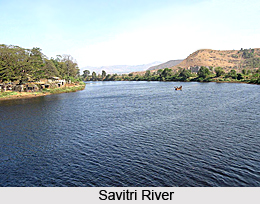 Savitri River is one of the five rain-fed rivers in the Maharashtra state of India. Savitri River originates from Mahabaleshwar in Maharashtra and flows through Raigad District and eventually meets Arabian Sea at Harehareshwar.
Savitri River is one of the five rain-fed rivers in the Maharashtra state of India. Savitri River originates from Mahabaleshwar in Maharashtra and flows through Raigad District and eventually meets Arabian Sea at Harehareshwar.
The river passes through Poladpur taluk, Mahad taluk, Mangaon taluk and Shrivardhan taluk. This river is the lifeline of these taluks. There are a number of Hindu temples dedicated to Lord Shiva along the banks of river Savitri.
In last 100 km it forms the border between Raigad District and Ratnagiri District. Its major tributary is the Kal River which enters from the right (north) near Dasgaon District.
Mythological Story of Savitri River
There is a mythological story behind the origin of this river. Legends believe that Lord Brahma was performing Yagna in this region along with Vishnu, Shiva, and Brahma`s younger consort Gayatri. But somehow, Brahma forgot to wait for his senior consort Savitri. When Savitri arrived at the occasion she felt offended and humiliated. In her anger she transformed everyone into rivers. In revenge, they also transformed Savitri into the river recognized as Savitri River. Lord Vishnu started to flow east while Shiva began to flow south. Lord Vishnu and Shiva came to be known as River Krishna and River Koyna respectively.
This article is a stub. You can enrich by adding more information to it. Send your Write Up to content@indianetzone.com















